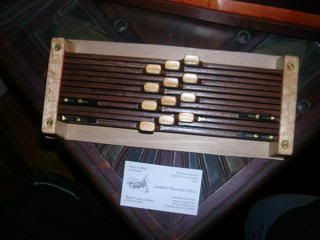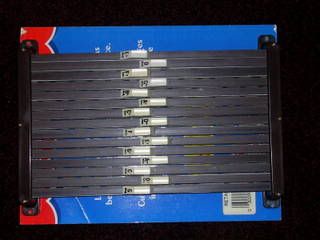A Conversion Story (with Murder Ballads) Part One
The first time I saw an autoharp up close and personal, I was hooked. One of Bea's day care providers brought it in to play to the children. Bea must have been about a year old. I've always had a fascination with harps and zithers (Who doesn't?), and string instruments in general. I played the violin and piano in elementary and middle school, and I'm a sub-par but enthusiastic guitar player. The autoharp is accessible, affordable, has the haunting stringy sound, is perfect for blue grass and accompanying murder ballads. Most intriguing is that you hug it when you play it. What's not to love about it, the horrible sound it makes when it's out of tune notwithstanding?
My first autoharp was a gray Silvertone from the early 70's. I traded a Memphis bass guitar for it. It came with a cool "Mother Maybelle Carter Plays the Autoharp" record, a few metal finger picks, a tuning wrench, and broken chord bars that desperately needed refelting and some replacing. I fixed it with the generous help of the kind folks on the Cyberpluckers list. I should have replaced the strings, and perhaps sent it to someone who could make it completely playable, but I didn't really have the money, or the time. I played it as is with great frustration and joy. I knew there was something fun in there, because when it was in tune, and I pressed the right chords, even the dead strings didn't sound so bad.
When I was pregnant with Ingrid, I went on a purge and sold the Silvertone on eBay to a nice man in England. But I missed it! I knew I'd eventually do it right, and this summer, I embarked on a new autoharp adventure. I ordered a custom Timbreharp, 21 chord in zebra wood. It probably won't be finished until early-mid 2007. So what's a girl to do in the meantime? Well, I got a second harp to learn how to maintain and tinker on. So that I wouldn't have redundant autoharp set-ups, I decided to convert that second one from a 15 chord chromatic to a 10 chord diatonic 'harp that plays in F and C, with lock bars to dampen the B and B flat notes when appropriate. Have I lost you? Go back to the Cyberpluckers link and read up on why anyone would do such a thing. Basically diatonic harps may be somewhat limiting when you're jamming, but they have a full, rich sound. Since I really only play for myself, I can convert a song to the key of F or C (or the corresponding minor keys), and once the 21 chord chromatic Timbreharp is here, I'll try to be less shy and find some folks to jam with. 

This guinea pig harp is an Oscar Schmidt 1979 Model 15 EBH/R with an imitation rosewood finish (I think it’s an imitation rosewood finish and not a starburst finish) in pristine condition for its age. I got it on eBay, where you can get wonderful 'harps and total crap 'harps, and not know which til it arrives in the mail. I count myself lucky. It was bought new in 1979, only played a few times, and kept out of extreme temperatures. I can't say I got a bargain, there was a bidding war involved, and going purely on instinct I bid to my upper limit. But I did get a solid harp. I ordered a new set of strings and a custom set of wooden chord bars in walnut with birdseye maple chord buttons and bar covers from Lumbert Mountain Music. This is going to be a sexy little 'harp.
Last night I embarked on the first part of my conversion. I removed the existing chord bars and all the strings. I enhanced the experience with a pot of green tea (inspired by Alan Horvath's coversion story with coffee) and some murder ballads, and it was great fun to be had by me. I can see how autoharp modification can become an addictive hobby. I wish I had some wood appliqués to put on this baby. Next harp will be the art harp. I took the piano scale sticker off, though.
After reading the chapter on restringing in the Autoharp Owner's Manual I carefully took the old chord bars off and unstrung it, removing the high octave strings first. After playing a few old Clannad songs, I moved on to Pentangle's version of "Cruel Sister" It really set the mood nice and dark. ("They made a harp of her breastbone...")
Oh how I love to take things apart! Once I got to removing the the middle octave, I moved on to a couple of versions of “Pretty Polly"--my very favorite murder ballad (first Darol Anger's 9 minute jam with Mary Chapin Carpenter singing, then Hilarie Burhans--a gem I heard at the end of a Deadwood episode). Well into the middle octave string removal, Primo came downstairs after taking a GMAT practice test, frazzled and bitchy. He'd not studied at all, and was scheduled to take the test on Wednesday (he has since rescheduled). I read him the reality riot act. [“Dude, you have no one but yourself to blame. You haven’t looked at the study book for a whole month, and your test is Wednesday? Stop complaining!”] I moved on to James Yorkston and the Athletes singing a creepily incestuous version of “Edward”, and noticed that someone had dropped a Popsicle stick in the sound hole! Prime suspect: Ingrid.
My conversation with Primo degenerated to Primo whining about wishing they'd let him play Scrabble instead of taking the GMAT. I suggested something much more uncomfortable that involved a very sensitive orifice, to which he joked he'd rather let them do than take the GMAT. Well, that was a little too dark for me, so with a very unpleasant image in my head of my dear husband being violated by the Admissions Committee at the Isenberg School of Management, I put on headphones and listened to some Gillian Welsh until I finished and had a naked autoharp. Primo watched CSI Miami and continued to complain about the GMAT. Poor honey! 
On a very sad note, I just heard there will be no more Deadwood episodes. Yet the Sopranos lives on. I don't understand it.
Stay tuned for more autoharp conversion escapades. I'm sure the next part will be interesting enough that I'll actually talk about what I do. Taking the strings of was easy. Next step: restringing!





No comments:
Post a Comment